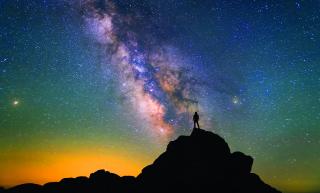Advertisement
To begin the dismantling of our racist language, we first need a new theology of darkness—a new way to relate to the darkness, blackness, and brownness that surrounds us, and to the people whose skin is often reflected in our disempowering language.
Poetry can help us cultivate a different relationship with and to blackness and darkness. In the darkness exists a time for rest, a time of regeneration and healing, a time of safety and nourishment, and a time of letting go to relax in God’s embrace.
As a spiritual humanist, I believe that which we call God—the energetic force of love and creation—is within us and around us, connecting and empowering us as we move toward one another and through the world. While there are many definitions of theology, I lead with a theology rooted in relationship with one another, the earth, God, the spirit of life, all that is holy, and the higher good that can occur when we recognize and affirm our interdependence. This relationship, both conscious and unconscious, impacts how we operate in the world, how we view and treat others, and how we respond to injustices in which we play a part.
As a student of religion and race for many decades, I have been concerned about the consistent equating of darkness and blackness with negative qualities such as sin and despair. Our connection to the divine is a deeply personal, driving force. Continuing to associate black and dark with “evil” or “the absence of God” has only contributed to fear, dehumanization, and violence toward Black and brown people. A new relationship with blackness and darkness should include lifting up the creation possible within the dark and its empowering and nurturing qualities.
“I have been concerned about the consistent equating of darkness and blackness with negativequalities such as sin and despair.”
Darkness has almost always been considered negative. In Old English, the word deorc meant “without light, obscure, gloomy, or sad, cheerless, sinister, wicked.” Phrases like “dark mood” and “dark night of the soul” only reinforce our negative feelings. We are taught to fear the dark—that all the monsters and demons come out in the dark. But those who hurt others under the guise of “battling monsters” do so as much in the daylight as in the night. The light does not hide war, famine, abuse, greed, torture, or any
other kind of violence. Light does not hide our sadness or depression, our loneliness or our despair. Darkness may even be a salve to the intensity of the light.
Those who follow seasonal rituals have attempted to reclaim the “dark times” as an important part of the natural order of things, but still often focus heavily on the return of light and the sun. Apart from a period of waiting for the sun to return, the dark is rarely celebrated for what it brings to our lives. Relearning to appreciate the darkness takes intention and practice.
The Darkness Divine
By Kristen L. Harper
God resides in depths of darkness
as in the light of sunbeams.
The moon shines brighter surrounded by night
and life is secure in the black waters of the womb.
As the night sky littered with stars demonstrates
again and again,
there is beauty in darkness and beauty in light—
one no more brilliant than the other,
one no more necessary than the other,
one always complementing the other.
Without the heated darkness of the Universe,
splitting neutrons, electrons, and protons from atoms,
life and light would never be.
The task for us today
is to recognize God in both—
To see the divine in the rich brown earth,
the textured black walnut,
as well as the white snow and the pale pink jellyfish.
To see the sacred in the panther and the swan.
To embrace the dignity of the Black Madonna,
as it is embodied in the Virgin Mary.
The task for us today
is to look into the multifaceted colors of the onyx
and see the miraculous spectrum of color
produced in the prism of a diamond.
Questions for Discussion
- What is your relationship to God, to the holy, to nature, to humanity?
- What is your relationship to black, brown, and darkness?
- What impact does the negative use of the words dark and black have on you?
- What is some positive imagery of darkness and blackness?
- What words might you use to replace dark and black to describe your mood or experience?
- How might a positive understanding of black and dark deepen your relationship with the holy?
White Readers
How might your understanding of black and dark deepen your relationship with people who are Black or brown?
Readers of Color
How might your understanding of black and dark change how we perceive ourselves?
Exercises
- Write three sentences where you replace the word dark or black for other descriptive terms. For example, instead of “I was in a dark mood,” try writing “I was in a foul mood.”
- Create a poem where you describe the beauty and/or power of blackness or the dark.
- Imagine God as a dark, comforting, healing, creative blanket. Compose a prayer or meditation where this holy darkness is the central theme.
- As you go about your week, seek positive black, brown, and dark imagery, and record it in a journal.
